Modeling of the Arc Characteristics inside a Thermal Laminar Plasma Torch with Different Gas Components
Abstract
:1. Introduction
2. Modeling of the Laminar Plasma Torch
2.1. Assumptions
- The plasma flow is in a local thermodynamic equilibrium (LTE) in the plasma torch except for the near-electrode region. Non-LTE in the near-electrode region is considered.
- The effect of radiation reabsorption of the plasma flow inside the laminar plasma torch is ignored.
- The inter-electrodes are simplified as water-cooled walls with a specified temperature.
- Considering the small flow Mach number, which is calculated theoretically, the viscous dissipation term in the energy equation can be ignored.
- The phase transition of the electrode material is ignored.
- The plasma gas is treated as a monophasic continuous fluid, which is characterized by a single temperature for all species. The transport properties are functions of the temperature only.
- The flow Mach number is about 0.5.
2.2. Governing Equations
2.2.1. Governing Equations of the Plasma Flow
- (1)
- Mass conservation equation:
- (2)
- The momentum conservation equation:
- (3)
- The energy conservation equation:
- (4)
- The electric current conservation equation:
- (5)
- The Ampere–Maxwell equation:
2.2.2. Governing Equations of the Solid Regions
2.2.3. Simulation Model
2.3. Material Properties
- (1)
- Thermodynamic and transport properties of plasma gases
- (2)
- Net radiation coefficients
2.4. Laminar Plasma Torch Geometry and Computational Domain
2.5. Mesh Generation
2.6. Boundary Conditions
2.6.1. Near-Electrode Boundary
- 1.
- Near the cathode
- (1)
- Current density
- (2)
- Heat flux
- (3)
- Cathode voltage drop
- 2.
- Near the anode
2.6.2. Other Boundary Conditions
2.7. Solving Method
3. Simulation and Experimental Conditions
3.1. Working Conditions
3.2. Experimental Setups
4. Results and Discussion
4.1. Simulation and Experimental Results in the Near-Electrode Regions
4.1.1. Results in the Near-Anode Region
4.1.2. Results in the Near-Cathode Region
4.2. Temperature Distributions
4.2.1. Temperature Distributions by Using Pure Nitrogen
4.2.2. Temperature Distributions by Using Pure Argon
4.2.3. Temperature Distributions by Using 50%Ar + 50%N2.
4.2.4. Comparison Analysis of Different Gas Compositions
4.3. Velocity Distributions
4.3.1. Velocity Distributions by Using Pure Nitrogen
4.3.2. Velocity Distributions by Using Pure Argon
4.3.3. Velocity Distributions by Using 50%Ar + 50%N2
4.3.4. Comparison Analysis of Different Gas Compositions
4.4. Arc Voltage Characteristics
5. Conclusions
- (1)
- Assumptions, governing equations, boundary conditions, and solving methods were discussed in detail for building a proper numerical model of a laminar plasma torch. The effectiveness of the corresponding numerical model was verified by experiments.
- (2)
- The axial temperature distributions inside the laminar plasma torch with different gas compositions can be divided into three sections along the axis: peak temperature area (10 mm < x < 20 mm), stable temperature area (20 mm < x < 62 mm), and decreased temperature area (62 mm < x < 95 mm). In the peak temperature area, the temperature increases sharply to a certain level and then decreases slightly. In the stable temperature area, the temperature of the arc column varies little. In the decreased temperature area, the disappearance of the heat effect of the plasma arc caused a decrease in the arc temperature.
- (3)
- The axial velocity distributions inside the laminar plasma torch with different gas compositions increase to a certain level first and then decrease. Moreover, the axial velocity of pure nitrogen is much higher than that of pure argon and 50%Ar + 50%N2, while that of pure argon and 50%Ar + 50%N2 has little difference.
- (4)
- The simulated arc voltage trend is in accordance with the corresponding experimental arc voltage trend, indicating the effectiveness of the numerical model of the homemade laminar plasma torch.
Author Contributions
Funding
Data Availability Statement
Conflicts of Interest
References
- Van, G. Applications of Thermal Plasmas for the Environment. Appl. Sci. 2022, 12, 7185. [Google Scholar] [CrossRef]
- Shahabuddin, K.; Riaz, K.; Shahid, H. Suitability of thermal plasma for solid waste treatment and non-thermal plasma for nano-scale high-tech plasmonic materials: A concise review. Appl. Nanosci. 2022, 12, 1–16. [Google Scholar]
- Boulos, M.I.; Fauchais, P.L.; Pfender, E. Handbook of Thermal Plasmas; Springer: Berlin/Heidelberg, Germany, 2020. [Google Scholar]
- Liu, S.; Zhang, S.; Li, C.; Li, L.; Huang, J.-H.; Trelles, J.P.; Murphy, A.B.; Li, C.-J. Generation of Long Laminar Plasma Jets: Experimental and Numerical Analyses. Plasma Chem. Plasma Process. 2019, 39, 377–394. [Google Scholar] [CrossRef]
- Emilie, L.; Charles, D.-I. Experimental characterization of an argon laminar plasma jet at atmospheric pressure. J. Phys. D Appl. Phys. 2011, 44, 415201. [Google Scholar]
- Chen, X.; Pan, W.; Meng, X.; Cheng, K.; Xu, D.-Y.; Wu, C. What do we know about long laminar plasma jets. Pure Appl. Chem. 2006, 78, 1253–1264. [Google Scholar] [CrossRef]
- Cao, X.; Yu, D.; Xiao, M.; Miao, J. Design and characteristics of a laminar plasma torch for materials Processing. Plasma Chem. Plasma Process. 2016, 36, 693–710. [Google Scholar] [CrossRef]
- Ma, Y.; Ke, W.; Yang, K.; Zhu, X.D. Investigation on spheroidization of refractory tungsten powders by laminar DC plasma torch. Mater. Res. Express 2022, 9, 116516. [Google Scholar] [CrossRef]
- Liu, S.-H.; Gang, J.; Li, C.-J.; Li, C.-X.; Guo, H.-B. Novel long laminar plasma sprayed hybrid structure thermal barrier coatings for high-temperature anti-sintering and volcanic ash corrosion resistance. J. Mater. Sci. Technol. 2021, 79, 141–146. [Google Scholar] [CrossRef]
- Guo, D.; Yu, D.; Zhang, P.; Duan, Y. Laminar plasma jet surface hardening of the U75V rail steel: Insight into the hardening mechanism and control scheme. Surf. Coat. Technol. 2020, 394, 125857. [Google Scholar] [CrossRef]
- Keming, P.; Deping, Y.; Peng, Z.; Wang, L.; Liao, Z.; Lu, Z.; Wu, G.; Song, C.; Li, L. Laminar plasma quenching-tempering: A rapid surface heat treatment technique for controllable modification of the rail steel. Surf. Coat. Technol. 2023, 473, 130029. [Google Scholar]
- Pan, W.; Zhang, W.; Zhang, W.; Wu, C. Generation of long, laminar plasma jets at atmospheric pressure and effects of flow turbulence. Plasma Chem. Plasma Process. 2001, 21, 23–35. [Google Scholar] [CrossRef]
- Pan, W.; Meng, X.; Chen, X.; Wu, C. Experimental study on the thermal argon plasma generation and jet length change characteristics at atmospheric pressure. Plasma Chem. Plasma Process. 2006, 26, 335–345. [Google Scholar] [CrossRef]
- Pan, W.; Zhang, W.; Ma, W.; Wu, C. Characteristics of argon laminar DC plasma jet at atmospheric pressure. Plasma Chem. Plasma Process. 2002, 22, 271–283. [Google Scholar] [CrossRef]
- Li, G.; Pan, W.; Meng, X.; Wu, C. Application of similarity theory to the characterization of non-transferred laminar plasma jet generation. Plasma Sources Sci. Technol. 2005, 14, 219–225. [Google Scholar] [CrossRef]
- Solonenko, O.-P.; Smirnov, A.-V. Advanced oxide powders processing based on cascade plasma. J. Phys. Conf. Ser. 2014, 550, 12–17. [Google Scholar] [CrossRef]
- Solonenko, O.-P.; Nishiyama, H.; Smirnov, A.-V.; Takana, H. Visualization of arc and plasma flow patterns for advanced material processing. J. Vis. 2015, 18, 221–235. [Google Scholar] [CrossRef]
- Cao, X.; Guo, W.; Hu, G.; Ma, Y. Design and Experimental Jet Characteristics of an Optimized DC Plasma Torch. IEEE Trans. Plasma Sci. 2022, 50, 4873–4881. [Google Scholar] [CrossRef]
- Cao, X.; Li, C.; He, R.; Xu, H.; Chen, L.; Huang, B. Study on the influences of the anode structures on the jet characteristics of a laminar plasma torch. Plasma Res. Express 2020, 2, 18001. [Google Scholar] [CrossRef]
- Cao, X.; Chen, L. Design and characteristics of a new type laminar plasma torch for materials processing. Plasma Sci. Technol. 2019, 22, 402–410. [Google Scholar] [CrossRef]
- Cao, X.; Yu, D.; Xiang, Y.; Yao, J. Influence of the Gas Injection Angle on the Jet Characteristics of a Non-transferred DC Plasma Torch. Plasma Chem. Plasma Process. 2016, 36, 881–889. [Google Scholar] [CrossRef]
- Liu, S.; Trelles, J.P.; Murphy, A.B.; Li, L. Numerical simulation of the flow characteristics inside a novel plasma spray torch. J. Phys. D Appl. Phys. 2019, 52, 335203. [Google Scholar] [CrossRef]
- Zhukovskii, R.; Chazelas, C.; Vardelle, A.; Rat, V. Control of the Arc Motion in DC Plasma Spray Torch with a Cascaded Anode. J. Therm. Spray Technol. 2020, 29, 3–12. [Google Scholar] [CrossRef]
- Murphy, A.-B.; Arundell, C.-J. Transport coefficients of argon, nitrogen, oxygen, argon-nitrogen, and argon-oxygen plasmas. Plasma Chem. Plasma Process. 1994, 14, 451–490. [Google Scholar] [CrossRef]
- Lowke, J.-J. Predictions of arc temperature profiles using approximate emission coefficients for radiation losses. J. Quant. Spectrosc. Radiat. Transf. 1974, 14, 111–122. [Google Scholar] [CrossRef]
- Murphy, A.-B.; Uhrlandt, M.-D. Foundations of High-Pressure Thermal Plasmas. Plasma Sources Sci. Technol. 2018, 27, 063001. [Google Scholar] [CrossRef]
- Lisnyak, M.; Cunha, M.; Bauchire, J.; Benilov, M.S. Numerical modelling of high-pressure arc discharges: Matching the LTE arc core with the electrodes. J. Phys. D Appl. Phys. 2017, 50, 315203. [Google Scholar] [CrossRef]
- Jüttner, B. Cathode spots of electric arcs. J. Phys. D Appl. Phys. 2001, 34, R103. [Google Scholar] [CrossRef]
- Murphy, A.B.; Tanaka, M.; Yamamoto, K.; Tashiro, S.; Sato, T.; Lowke, J.J. Modelling of thermal plasmas for arc welding: The role of the shielding gas properties and of metal vapour. J. Phys. D Appl. Phys. 2009, 42, 194006. [Google Scholar] [CrossRef]
- Benilov, M.S.; Almeida, N.A.; Baeva, M.; Cunha, M.D.; Benilova, L.G.; Uhrlandt, D. Account of near-cathode sheath in numerical models of high-pressure arc discharges. J. Phys. D Appl. Phys. 2016, 49, 215201. [Google Scholar] [CrossRef]
- Heberlein, J.; Mentel, J.; Pfender, E. The anode region of electric arcs: A survey. J. Phys. D Appl. Phys. 2010, 43, 23001. [Google Scholar] [CrossRef]
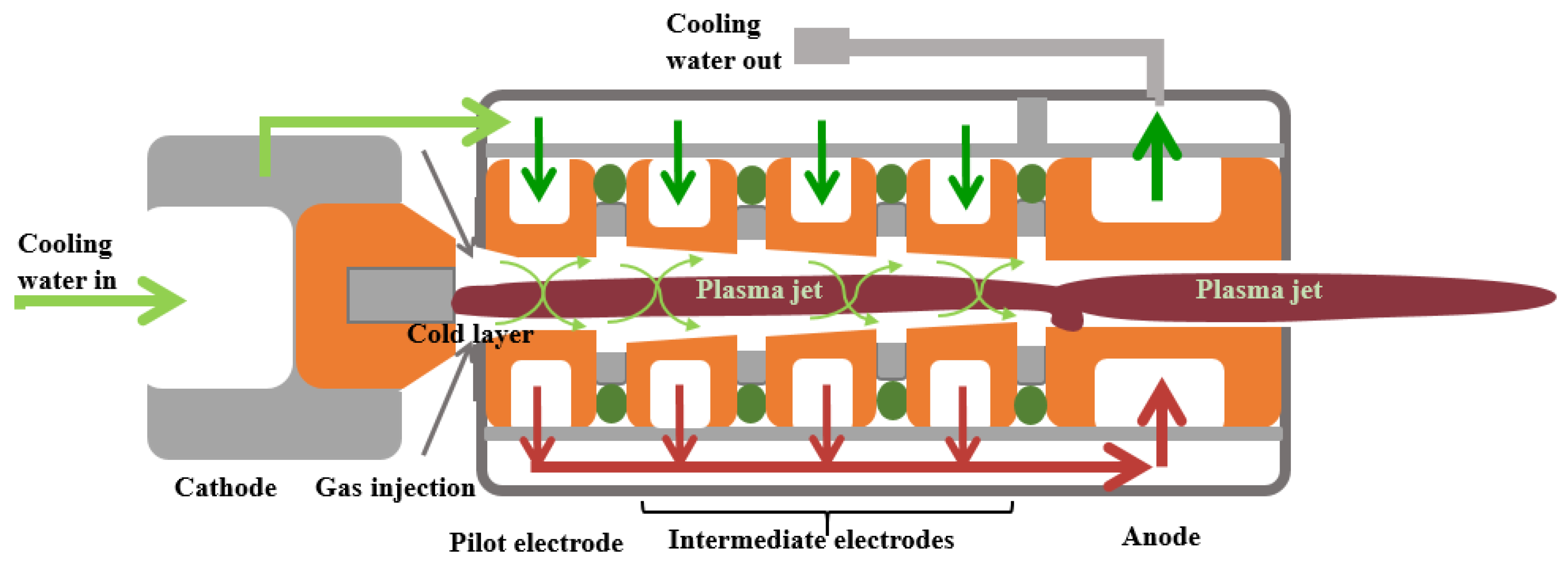


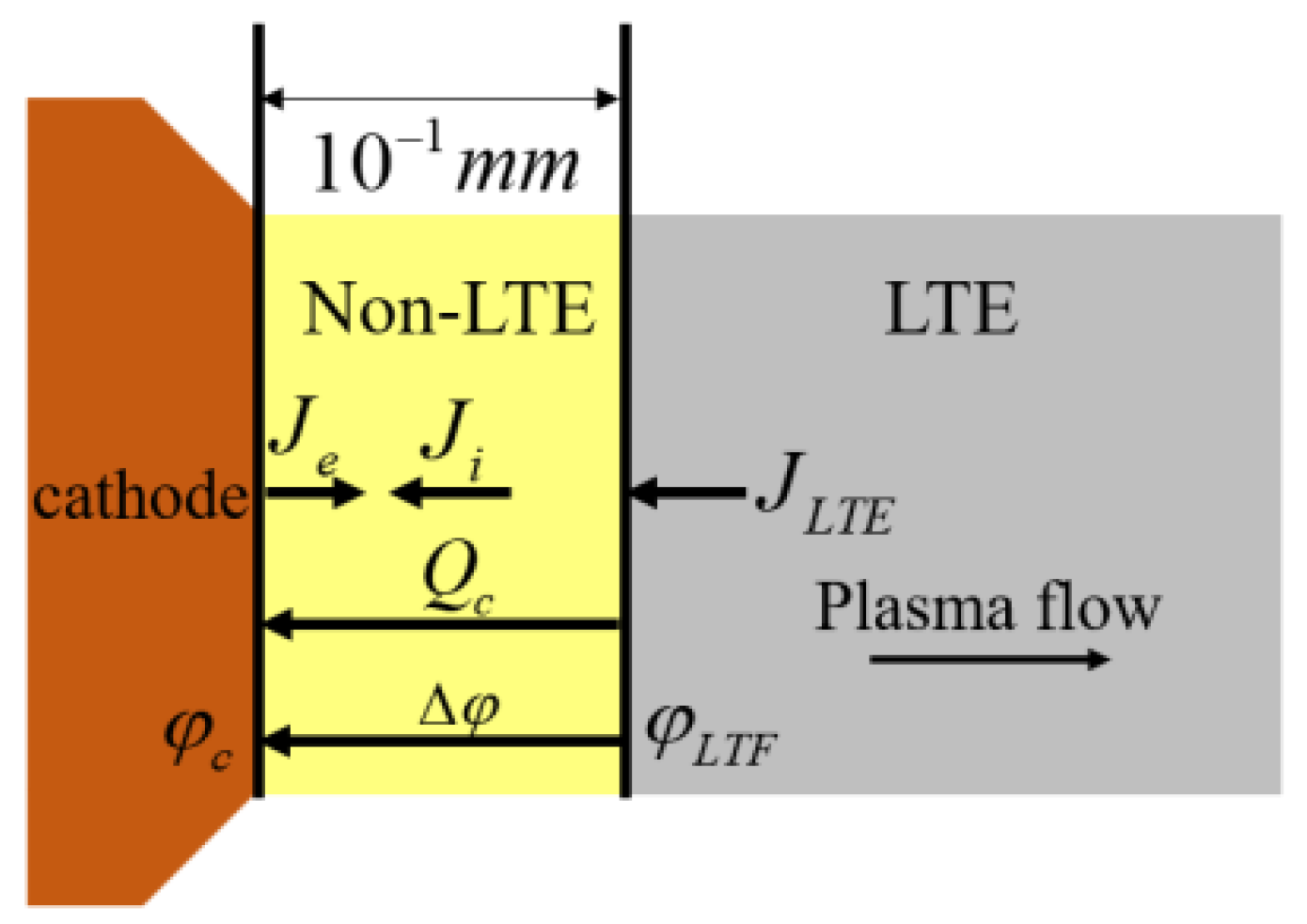
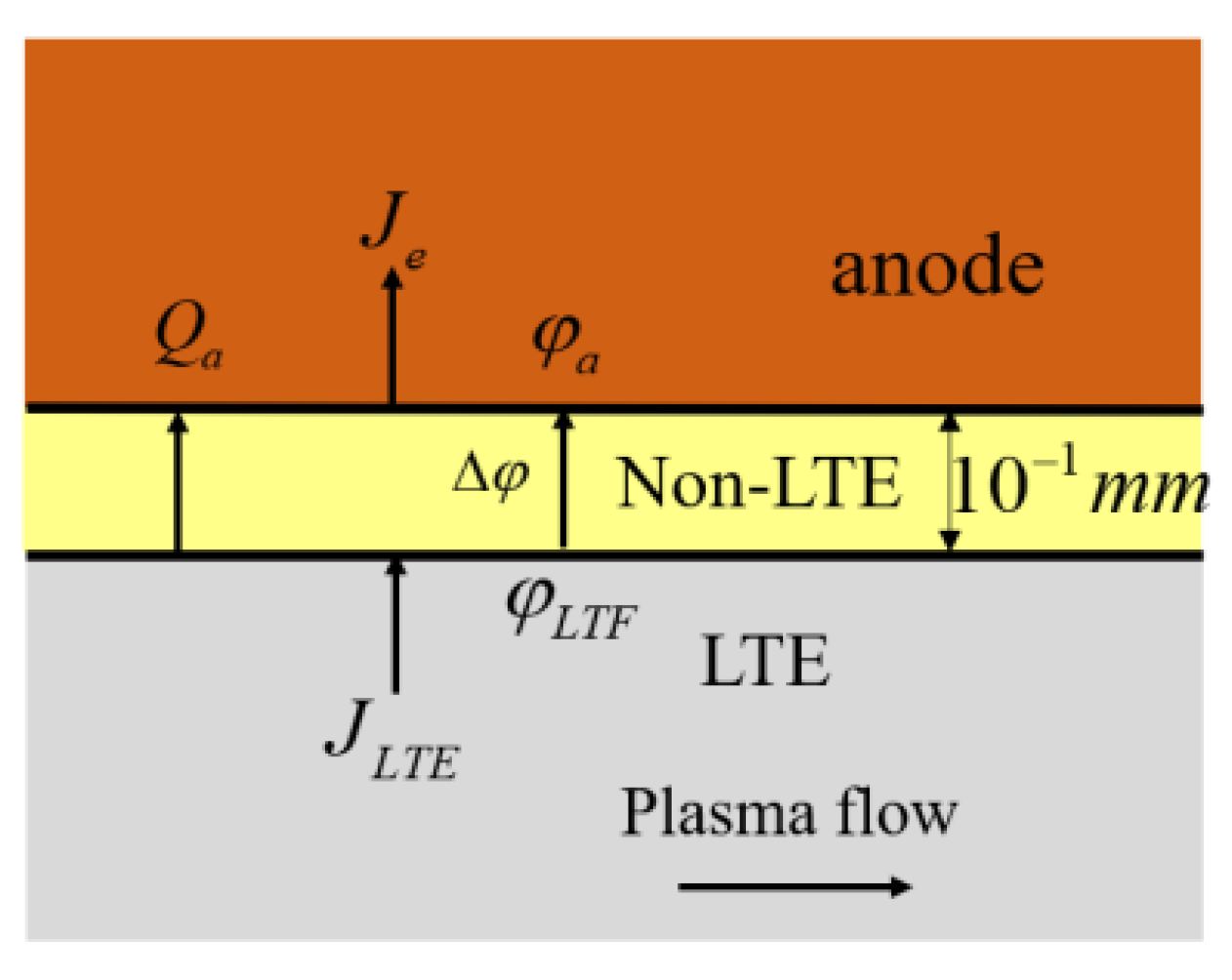
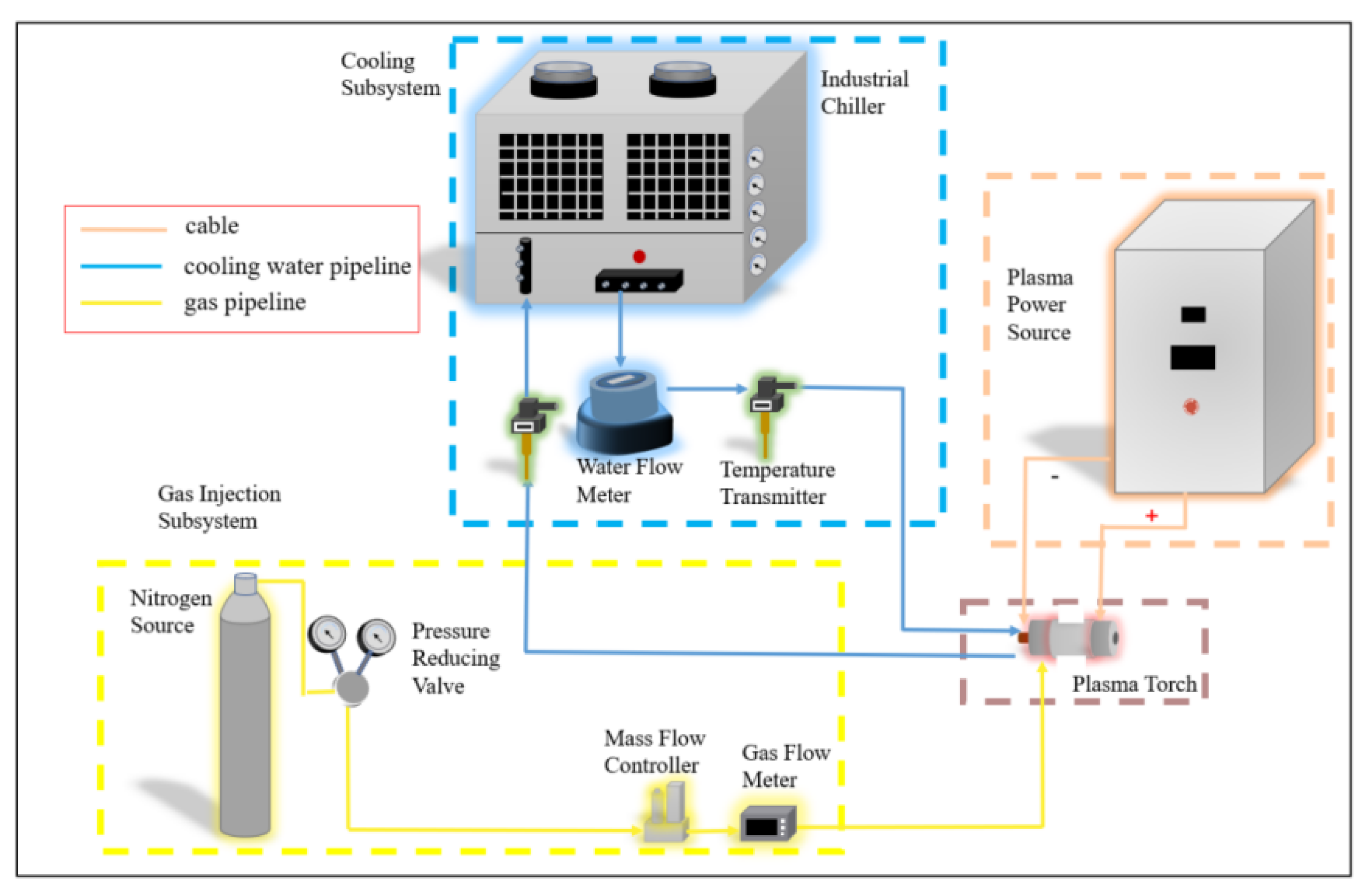
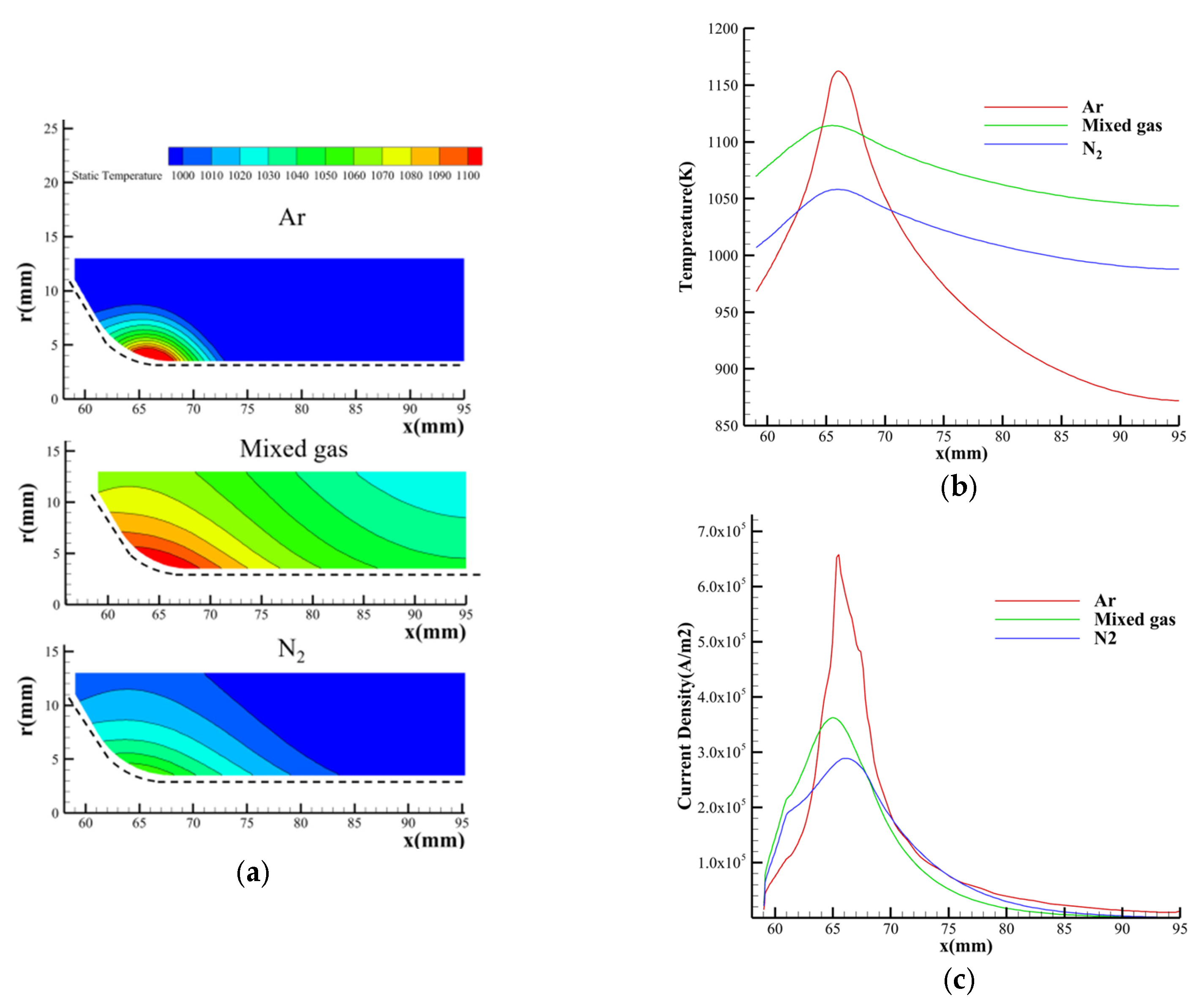
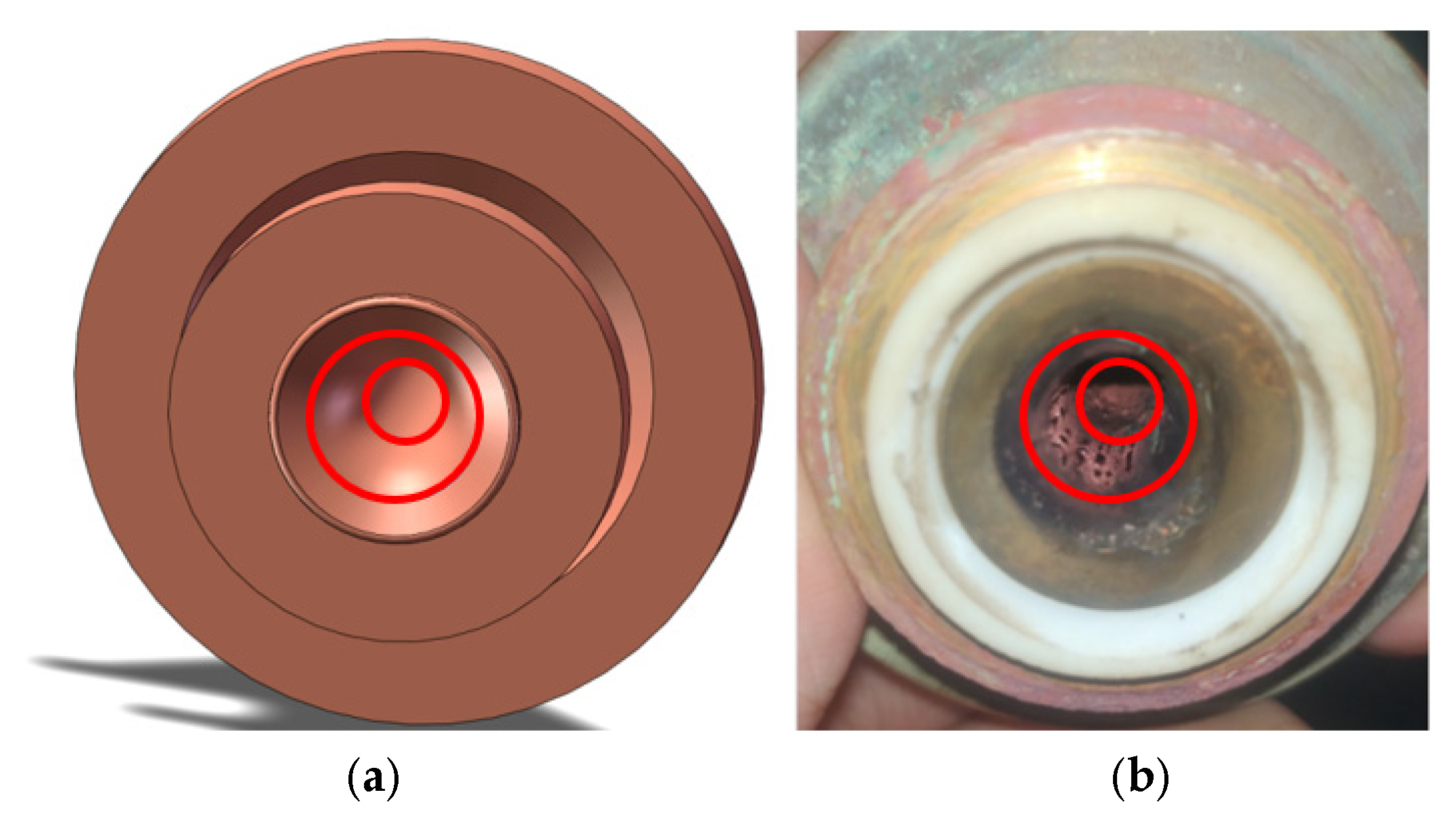
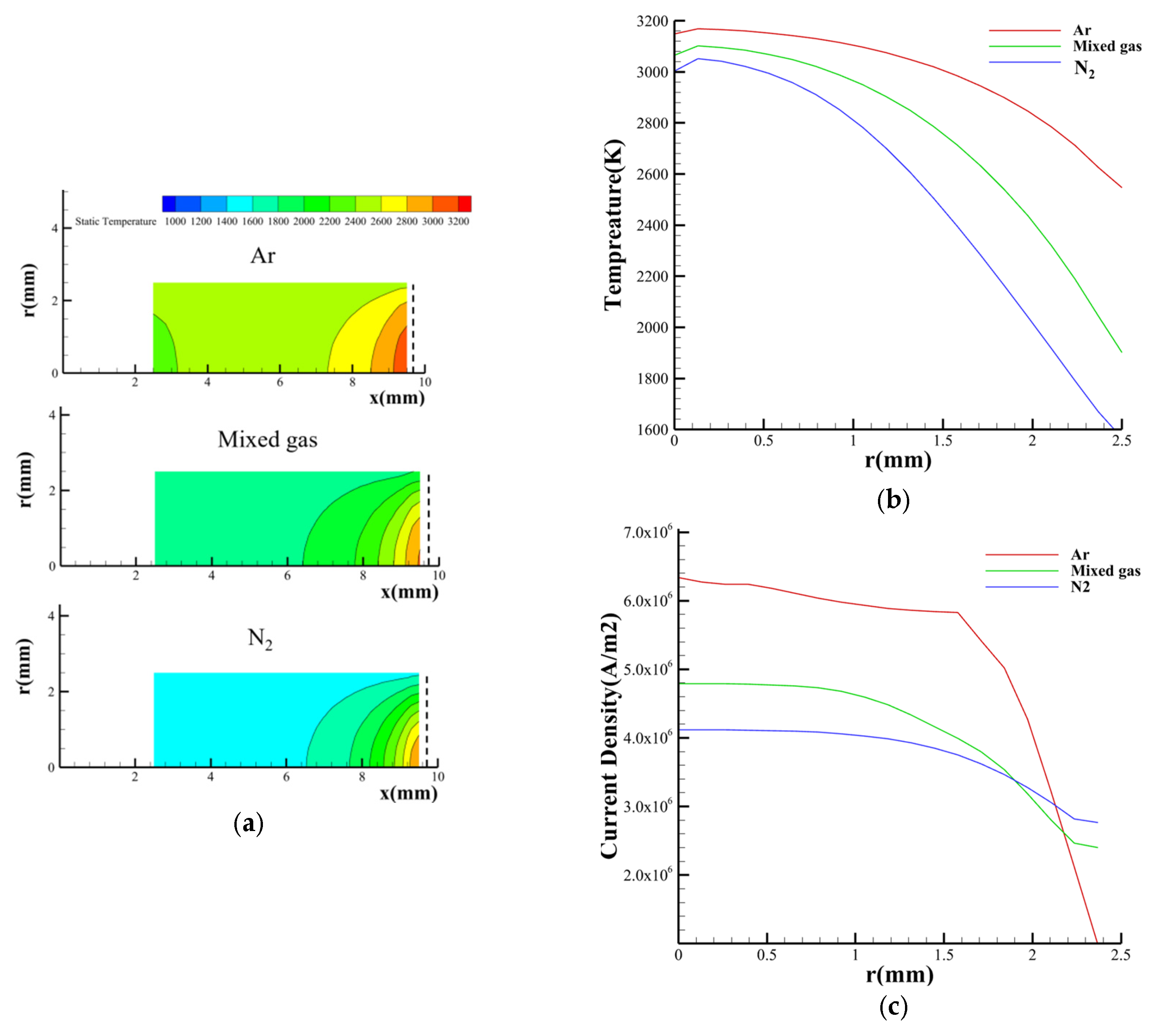
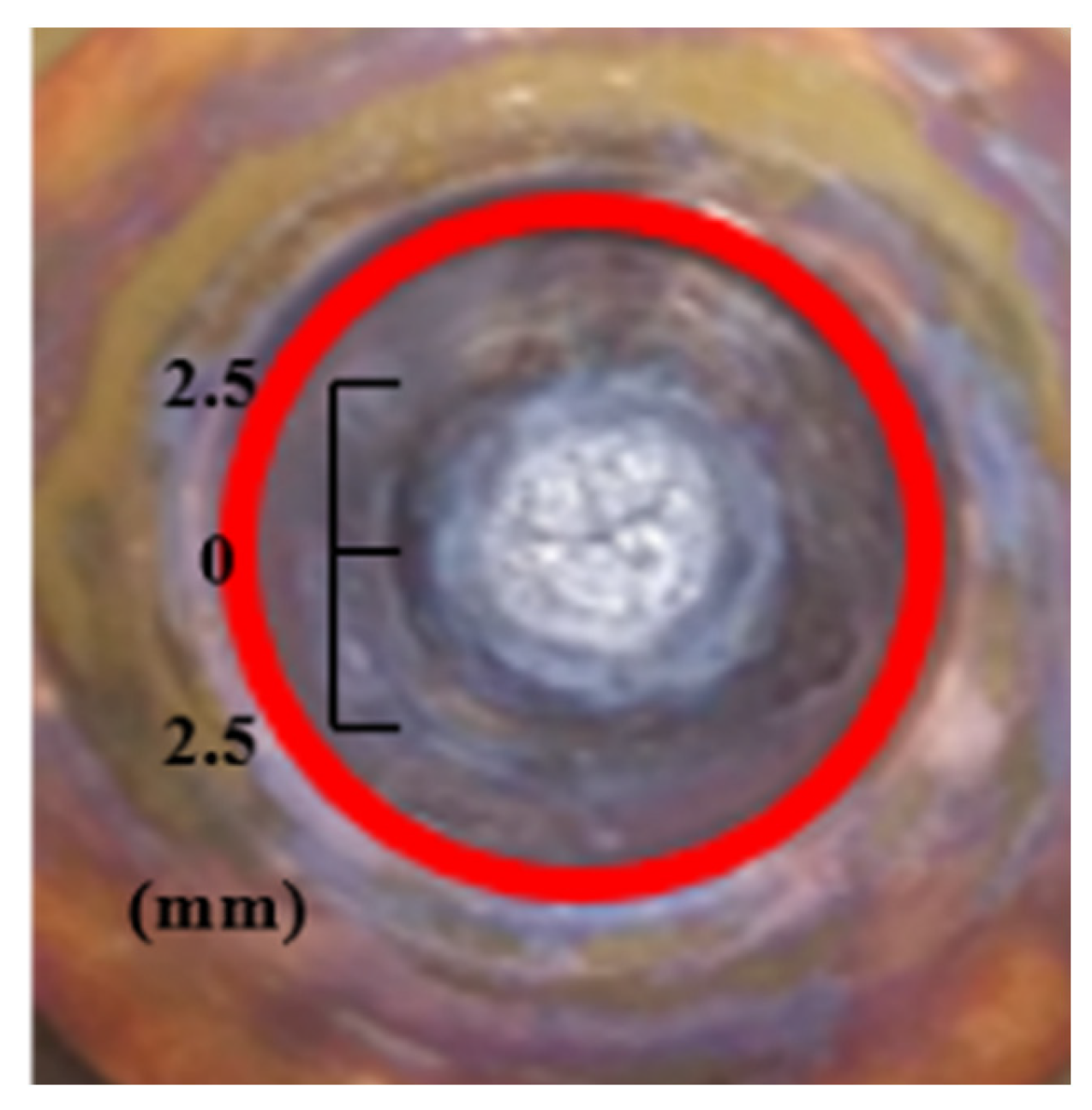



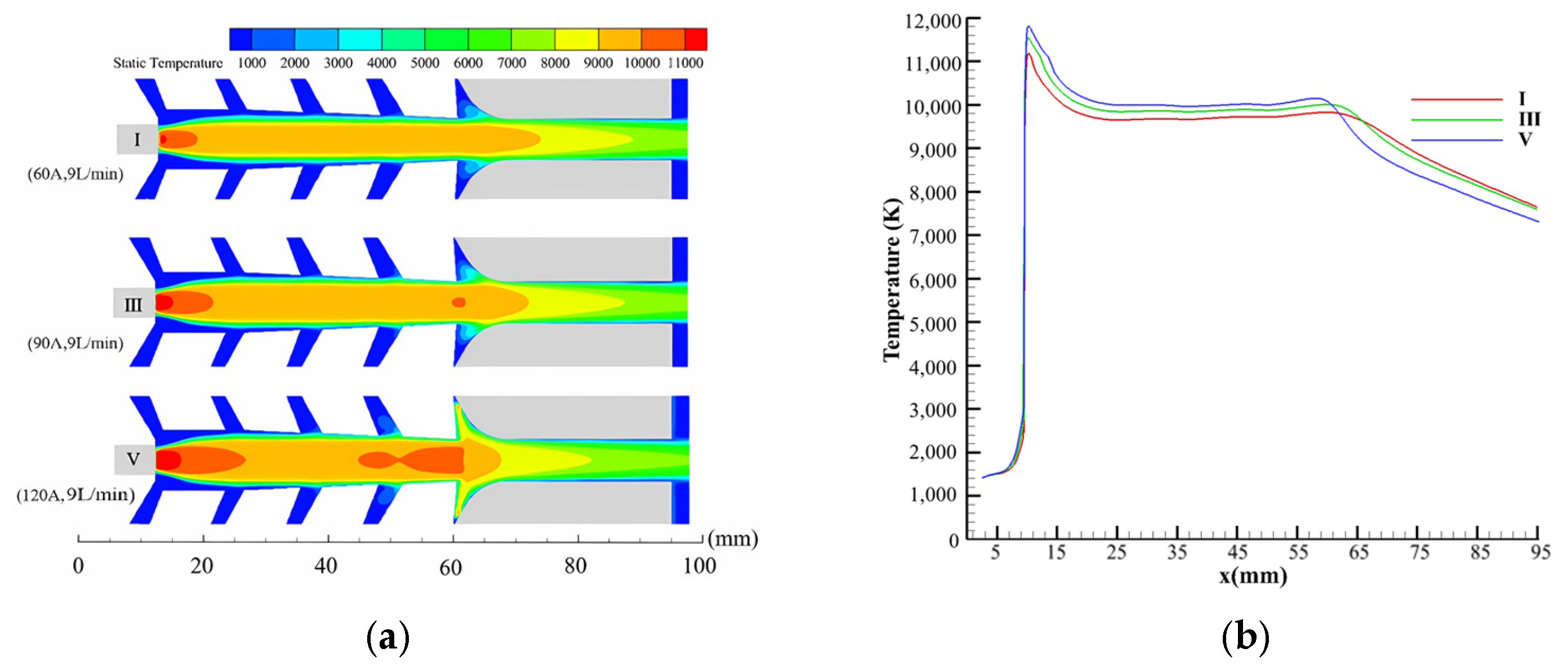
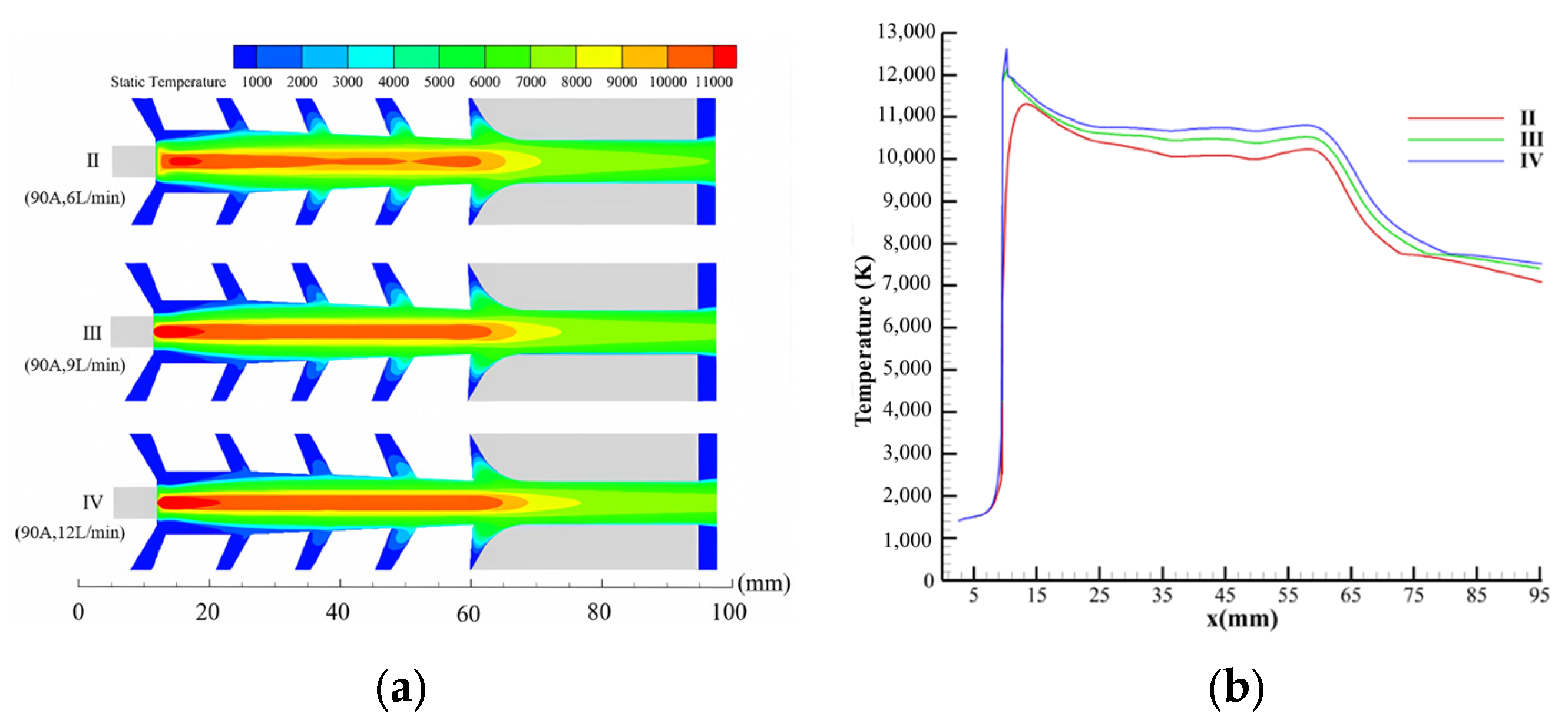


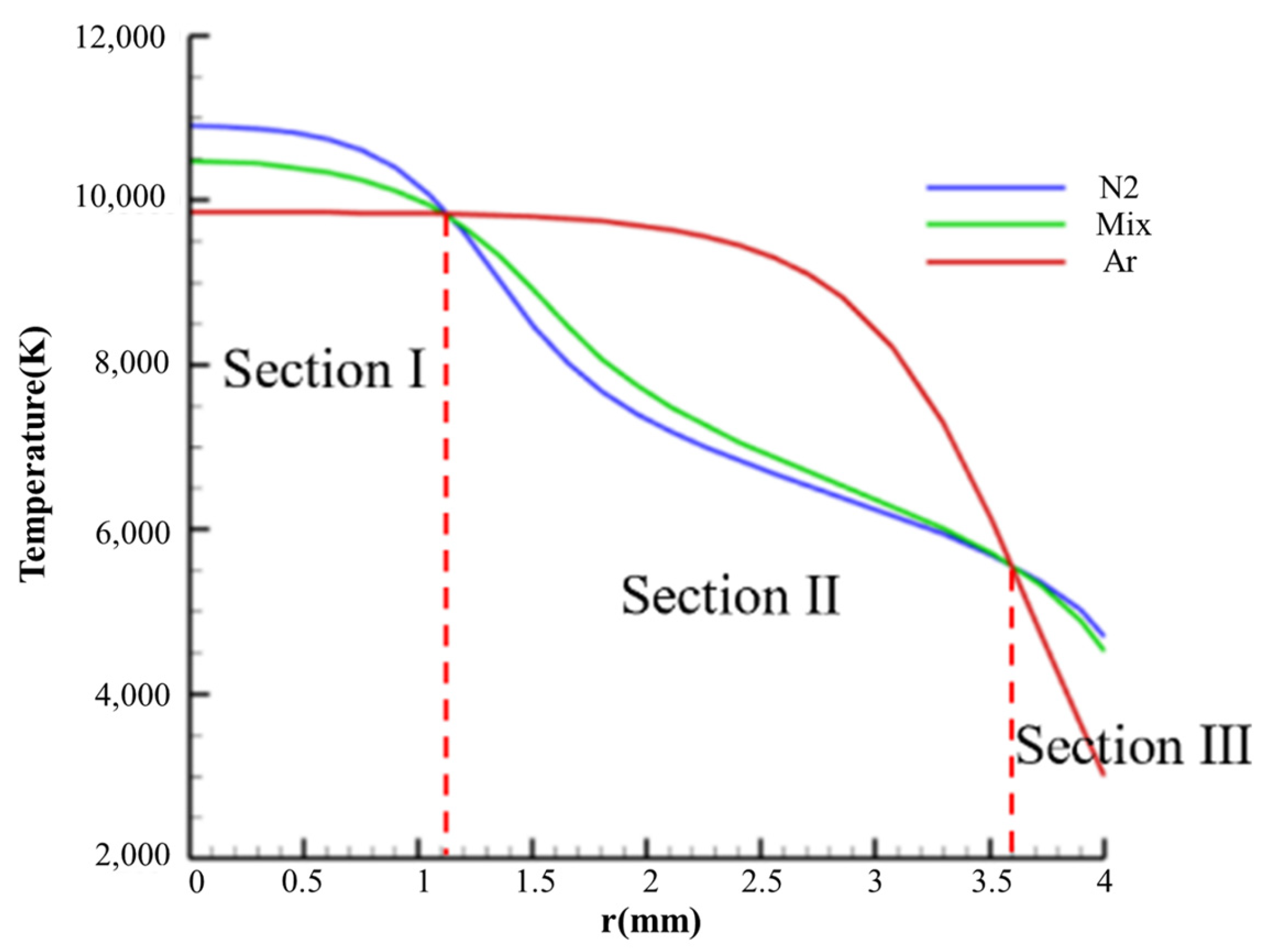

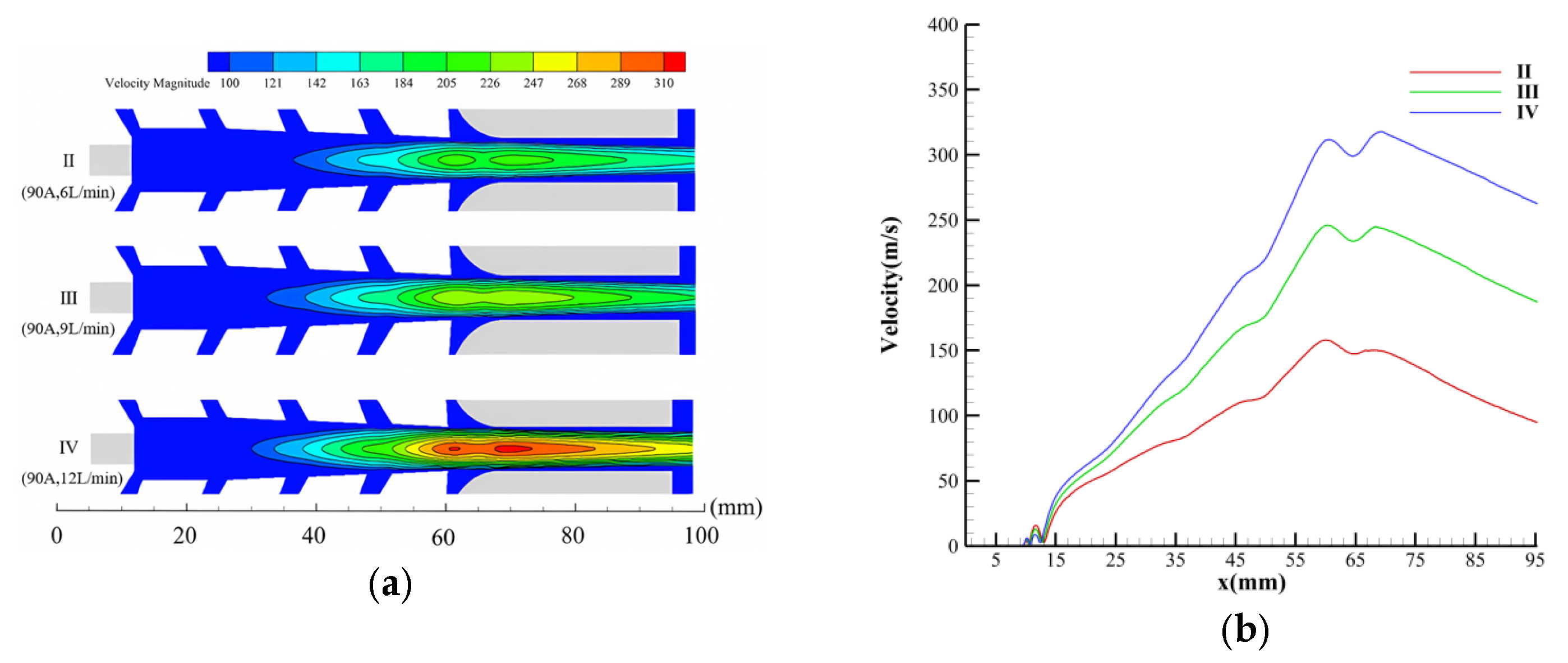

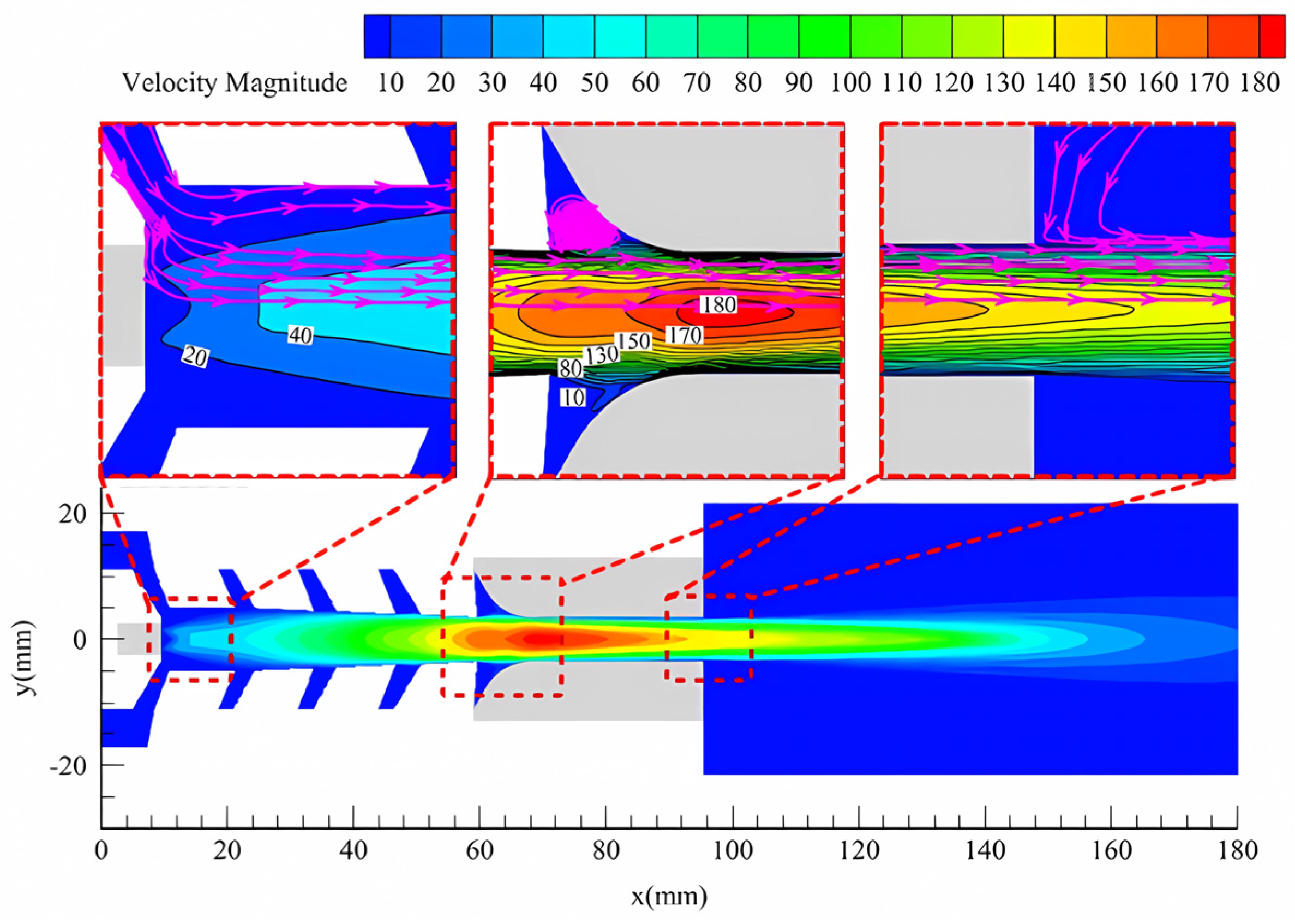


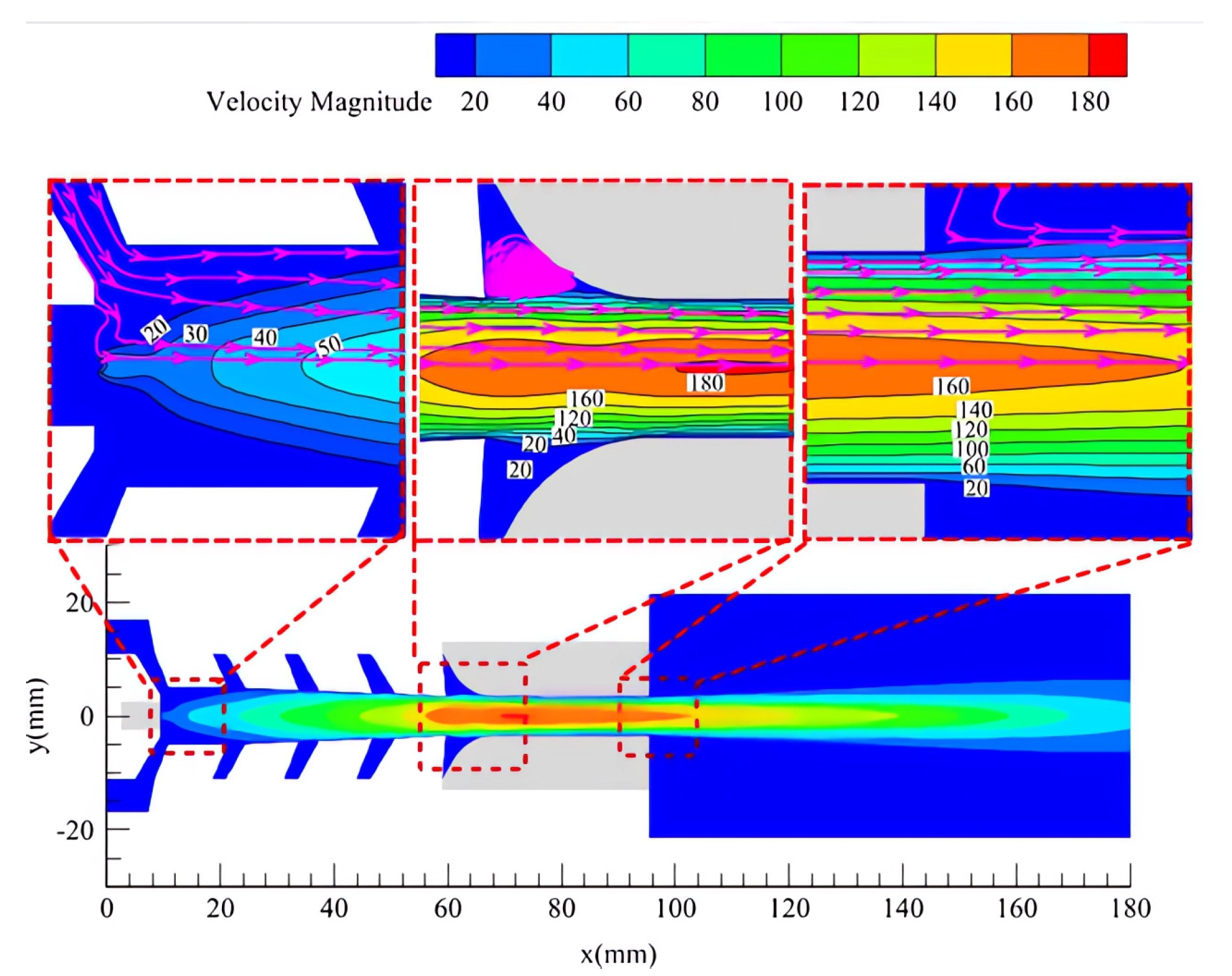
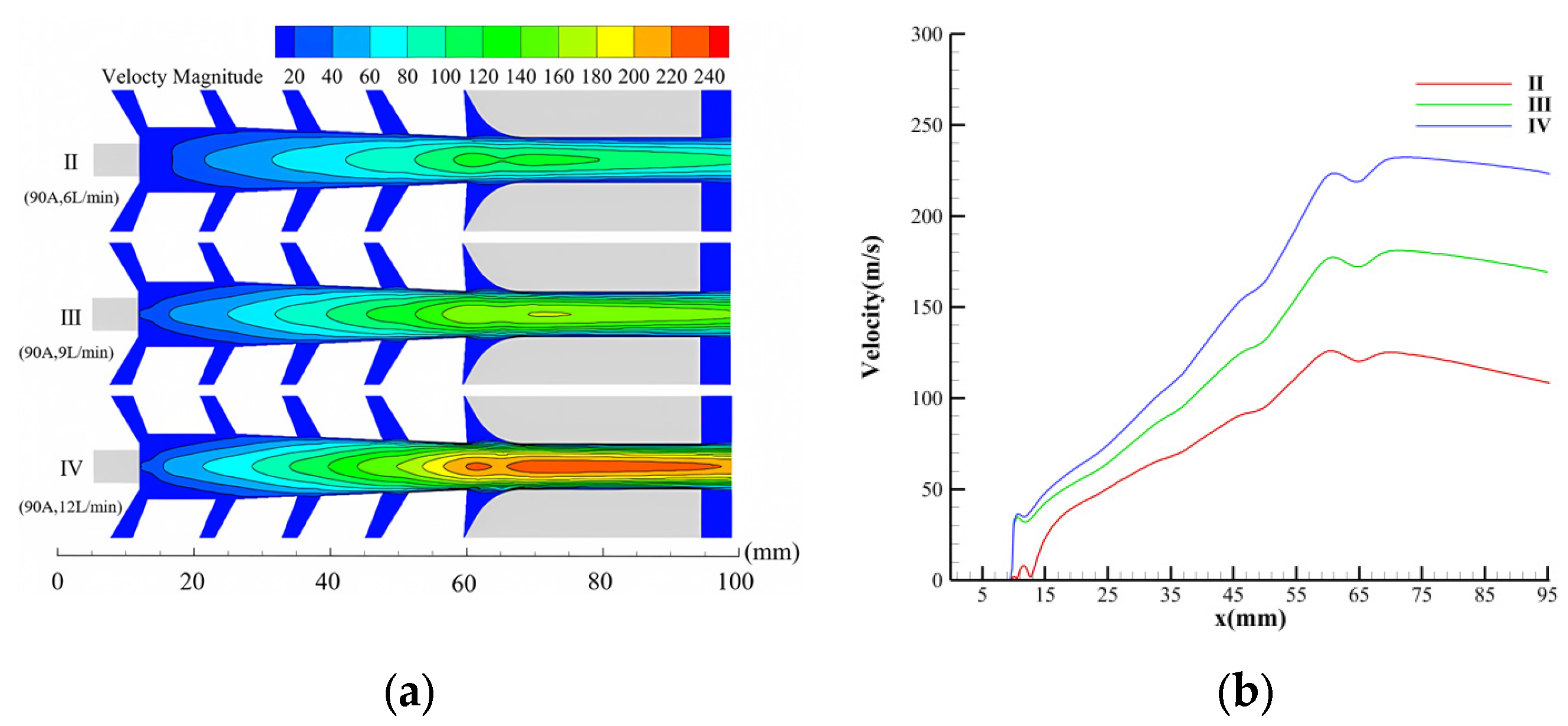
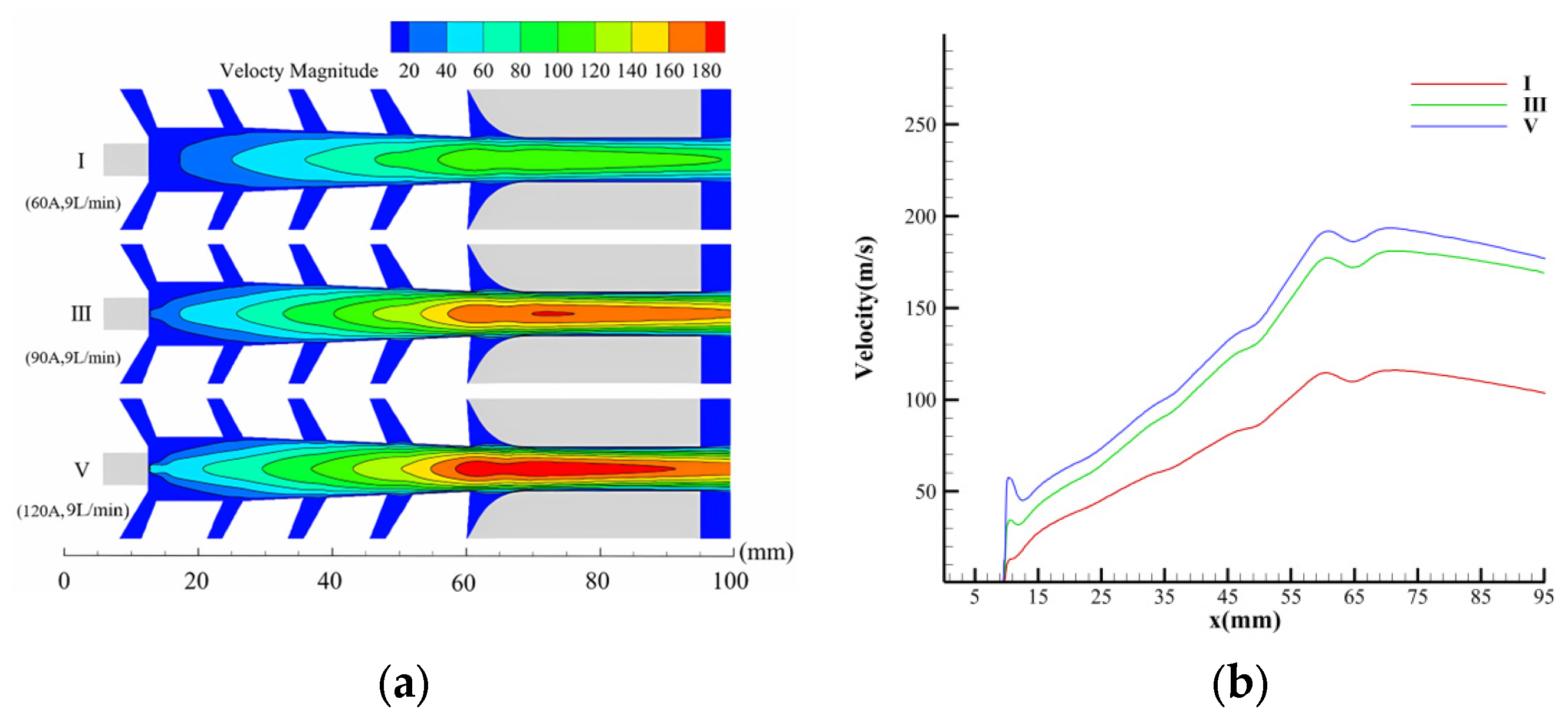
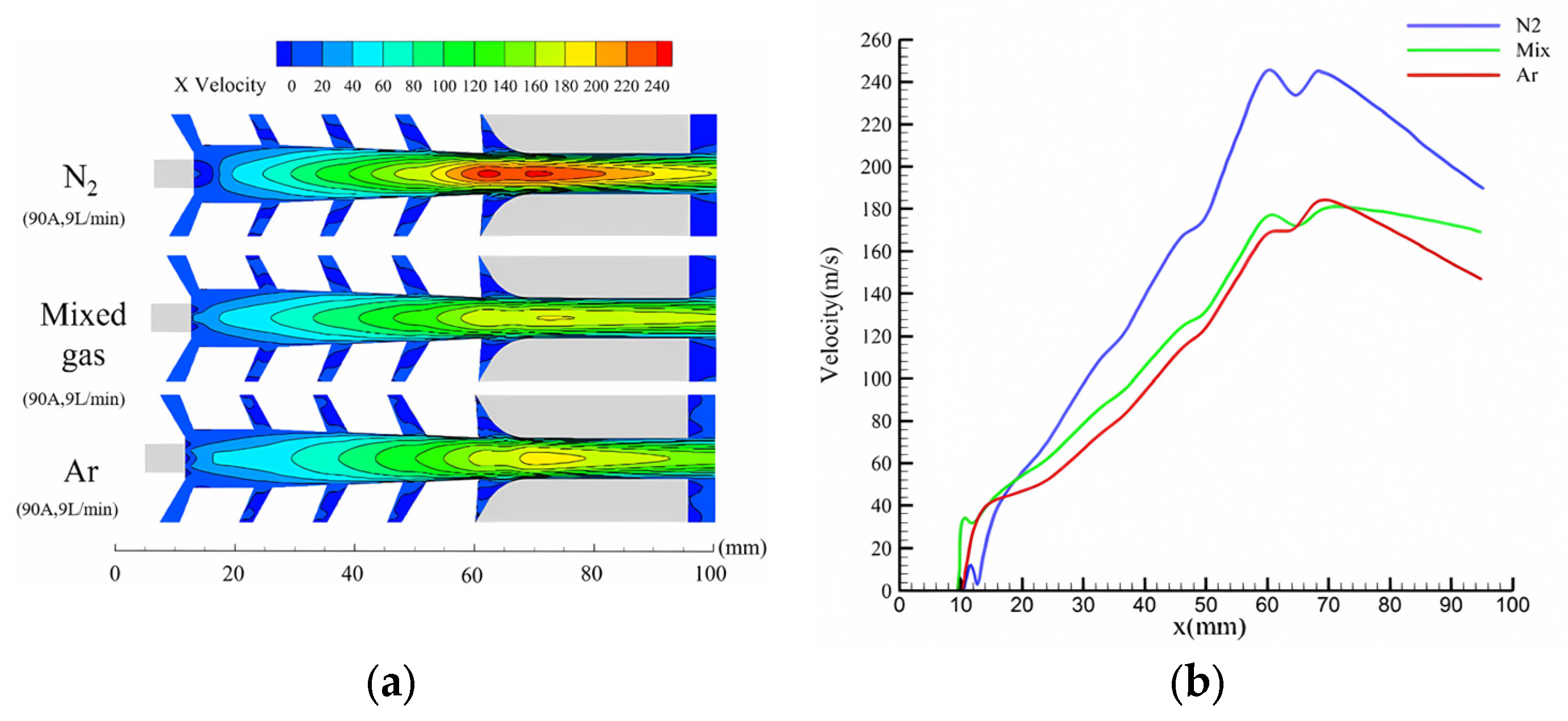


| Pressure | Gas Flow Rate | Temperature | Electric Potential | Magnetic Potential | Thermal Conductivity | |
|---|---|---|---|---|---|---|
| Pa | kg/s | K | V | Wb/m | H (W/m·K) | |
| EF | 2 × 105 | Qin | 300 | A = 0 | / | |
| AD | / | / | 300 | 1 × 104 | ||
| BC | / | / | Qc | / | ||
| GK | / | / | Qa | 0 | 1 × 104 | |
| IM | 0 | / | 300 | / | ||
| MN | 0 | / | 300 | / | ||
| Other walls | / | / | 300 | 1 × 104 |
| No. | Arc Current | Gas Flow Rate |
|---|---|---|
| I | 60 A | 9 L/min |
| II | 90 A | 6 L/min |
| III | 90 A | 9 L/min |
| IV | 90 A | 12 L/min |
| V | 120 A | 9 L/min |
Disclaimer/Publisher’s Note: The statements, opinions and data contained in all publications are solely those of the individual author(s) and contributor(s) and not of MDPI and/or the editor(s). MDPI and/or the editor(s) disclaim responsibility for any injury to people or property resulting from any ideas, methods, instructions or products referred to in the content. |
© 2024 by the authors. Licensee MDPI, Basel, Switzerland. This article is an open access article distributed under the terms and conditions of the Creative Commons Attribution (CC BY) license (https://creativecommons.org/licenses/by/4.0/).
Share and Cite
Tao, J.; Li, C.; Cao, X.; Li, S.; Wang, J.; Hu, G. Modeling of the Arc Characteristics inside a Thermal Laminar Plasma Torch with Different Gas Components. Processes 2024, 12, 1207. https://doi.org/10.3390/pr12061207
Tao J, Li C, Cao X, Li S, Wang J, Hu G. Modeling of the Arc Characteristics inside a Thermal Laminar Plasma Torch with Different Gas Components. Processes. 2024; 12(6):1207. https://doi.org/10.3390/pr12061207
Chicago/Turabian StyleTao, Jing, Changpeng Li, Xiuquan Cao, Shuangliang Li, Jingdong Wang, and Guangzhong Hu. 2024. "Modeling of the Arc Characteristics inside a Thermal Laminar Plasma Torch with Different Gas Components" Processes 12, no. 6: 1207. https://doi.org/10.3390/pr12061207
APA StyleTao, J., Li, C., Cao, X., Li, S., Wang, J., & Hu, G. (2024). Modeling of the Arc Characteristics inside a Thermal Laminar Plasma Torch with Different Gas Components. Processes, 12(6), 1207. https://doi.org/10.3390/pr12061207






